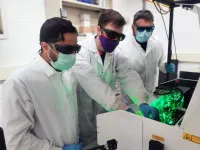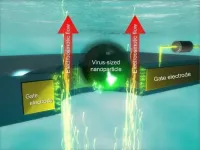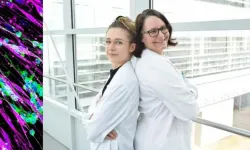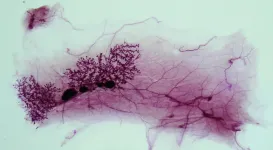(Press-News.org) CLEMSON, South Carolina -- By using laser spectroscopy in a photophysics experiment, Clemson University researchers have broken new ground that could result in faster and cheaper energy to power electronics.
This novel approach, using solution-processed perovskite, is intended to revolutionize a variety of everyday objects such as solar cells, LEDs, photodetectors for smart phones and computer chips. Solution-processed perovskite are the next generation materials for solar cell panels on rooftops, X-ray detectors for medical diagnosis, and LEDs for daily-life lighting.
The research team included a pair of graduate students and one undergraduate student who are mentored by Jianbo Gao, group leader of Ultrafast Photophysics of Quantum Devices (UPQD) group in the College of Science's Department of Physics and Astronomy.
The collaborative research was published March 12 in the high-impact journal Nature Communications. The article is titled "In-situ Observation of Trapped Carriers in Organic Metal Halide Perovskite Films with Ultra-fast Temporal and Ultra-high Energetic Resolutions."
The principal investigator was Gao, who is an assistant professor of condensed matter physics. The co-authors included graduate students Kanishka Kobbekaduwa (first author) and Pan Adhikari of the UPQD group, as well as undergraduate Lawrence Coleman, a senior in the physics department.
Other authors from Clemson were Apparao Rao, the R.A. Bowen Professor of Physics, and Exian Liu, a visiting student from China who works under Gao.
"Perovskite materials are designed for optical applications such as solar cells and LEDs," said Kobbekaduwa, a graduate student and first author of the research article. "It is important because it is much easier to synthesize compared to current silicon-based solar cells. This can be done by solution processing - whereas in silicon, you have to have different methods that are more expensive and time-consuming."
The goal of the research is to make materials that are more efficient, cheaper and easier to produce.
The unique method used by Gao's team - employing ultrafast photocurrent spectroscopy - allowed for a much higher time resolution than most methods, in order to define the physics of the trapped carriers. Here, the effort is measured in picoseconds, which are one trillionth of a second.
"We make devices using this (perovskite) material and we use a laser to shine light on it and excite the electrons within the material," Kobbekaduwa said. "And then by using an external electric field, we generate a photocurrent. By measuring that photocurrent, we can actually tell people the characteristics of this material. In our case, we defined the trapped states, which are defects in the material that will affect the current that we get."
Once the physics are defined, researchers can identify the defects - which ultimately create inefficiency in the materials. When the defects are reduced or passivated, this can result in increased efficiency, which is critical for solar cells and other devices.
As materials are created through solution processes such as spin coating or inkjet printing, the likelihood of introducing defects increases. These low temperature processes are cheaper than ultra-high temperature methods that result in a pure material. But the tradeoff is more defects in the material. Striking a balance between the two techniques can mean higher-quality and more efficient devices at lower costs.
The substrate samples were tested by shooting a laser at the material to determine how the signal propagates through it. Using a laser to illuminate the samples and collect the current made the work possible and differentiated it from other experiments that do not employ the use of an electric field.
"By analyzing that current, we are able to see how the electrons moved and how they come out of a defect," said Adhikari of the UPQD group. "It is possible only because our technique involves ultrafast time scale and in-situ devices under an electrical field. Once the electron falls into the defect, those who experiment using other techniques cannot take that out. But we can take it out because we have the electric field. Electrons have charge under the electric field, and they can move from one place to another. We are able to analyze their transport from one point to another inside the material."
That transport and the effect of material defects upon it can impact the performance of those materials and the devices in which they are used. It is all part of the important discoveries that students are making under the guidance of their mentor, creating ripples that will lead to the next great breakthrough.
"The students are not only learning; they are actually doing the work," Gao said. "I am fortunate to have talented students who - when inspired by challenges and ideas - will become influential researchers. This is all part of the important discoveries that students are making under the guidance of their mentors, creating ripples that will lead to the next great breakthrough. We are also very grateful for the strong collaborations with Shreetu Shrestha and Wanyi Nie, who are top materials scientists from Los Alamos National Laboratory."
INFORMATION:
Support for this project was provided by the Center for Integrated Nanotechnology at Los Alamos National Laboratory in Los Alamos, New Mexico, as well as the South Carolina Research Authority.
By Chris Worthy
Special to the College of Science
A multiyear workplace health promotion program can slow down the increase in health risks for working-age people. A study by the Faculty of Sport and Health Sciences at the University of Jyväskylä followed what kind of changes happened among participants during an eight-year workplace health promotion program in smoking, minor exercise, high blood pressure, musculoskeletal disorders, and overweight. The results of the study were encouraging for health promotion.
According to earlier studies, a high number of health risks are connected to an increase in occupational health care costs, lower productivity at work, and the growing number of sickness ...
CLEVELAND--Scientists at the Case Western Reserve University School of Medicine have determined the structure of protein "fibrils" linked to Lou Gehrig's disease and other neurodegenerative disorders--findings that provide clues to how toxic proteins clump and spread between nerve cells in the brain.
Their results may also lead to developing drugs to treat diseases such as amyotrophic lateral sclerosis (ALS) and frontotemporal dementia (FTD).
"These devastating brain disorders that affect tens of thousands of Americans?are on the rise worldwide, and there are no effective treatments to ...
Researchers at Tufts University School of Engineering have created light-activated composite devices able to execute precise, visible movements and form complex three-dimensional shapes without the need for wires or other actuating materials or energy sources. The design combines programmable photonic crystals with an elastomeric composite that can be engineered at the macro and nano scale to respond to illumination.
The research provides new avenues for the development of smart light-driven systems such as high-efficiency, self-aligning solar cells that automatically follow the sun's direction and angle of light, light-actuated microfluidic valves or soft robots that move with light on demand. A "photonic sunflower," whose petals curl ...
A new study led by University of Maryland and UCLA researchers found that DNA from tissue samples can be used to accurately predict the age of bats in the wild. The study also showed age-related changes to the DNA of long-lived species are different from those in short-lived species, especially in regions of the genome near genes associated with cancer and immunity. This work provides new insight into causes of age-related declines.
This is the first research paper to show that animals in the wild can be accurately aged using an epigenetic clock, which predicts age based on specific changes to DNA. This work ...
Osaka, Japan - Scientists from the Institute of Scientific and Industrial Research at Osaka University fabricated nanopores in silicon dioxide, that were only 300 nm, in diameter surrounded by electrodes. These nanopores could prevent particles from entering just by applying a voltage, which may permit the development of sensors that can detect very small concentrations of target molecules, as well as next-generation DNA sequencing technology.
Nanopores are tiny holes that are wide enough for just a single molecule or particle to pass through. The motion of nanoparticles through these holes ...
Researchers at UCL have solved a major piece of the puzzle that makes up the ancient Greek astronomical calculator known as the Antikythera Mechanism, a hand-powered mechanical device that was used to predict astronomical events.
Known to many as the world's first analogue computer, the Antikythera Mechanism is the most complex piece of engineering to have survived from the ancient world. The 2,000-year-old device was used to predict the positions of the Sun, Moon and the planets as well as lunar and solar eclipses.
Published in Scientific Reports, the paper from the multidisciplinary UCL Antikythera Research Team reveals a new display ...
PHILADELPHIA -- (March 12, 2021) -- Scientists at The Wistar Institute identified a new function of ADAR1, a protein responsible for RNA editing, discovering that the ADAR1p110 isoform regulates genome stability at chromosome ends and is required for continued proliferation of cancer cells. These findings, reported in Nature Communications, reveal an additional oncogenic function of ADAR1 and reaffirm its potential as a therapeutic target in cancer.
The lab of Kazuko Nishikura, Ph.D., professor in the Gene Expression & Regulation Program of The Wistar Institute Cancer Center, was one of the first to discover ADAR1 in mammalian cells and to characterize the process of RNA editing ...
A factor that turns malignant tumors into benign ones? - That is exactly what scientists at St. Anna Children's Cancer Research Institute have discovered. Together with colleagues from the Medical University of Vienna and the University of Vienna (Faculty of Chemistry), they studied tumors of the peripheral nervous system in children, namely neuroblastomas. The scientists discovered that the uncontrolled growth of benign neuroblastomas is stopped by a signal molecule produced by Schwann cells present within these tumors. This natural "brake" also works on malignant neuroblastoma ...
Brominated flame retardants (BFRs) are found in furniture, electronics, and kitchenware to slow the spread of flames in the event of a fire. However, it has been shown that these molecules may lead to early mammary gland development, which is linked to an increased risk of breast cancer. The study on the subject by Professor Isabelle Plante from the Institut national de la recherche scientifique (INRS) made the cover of the February issue of the journal Toxicological Sciences.
Part of the flame retardants are considered to be endocrine disruptors, i.e. they interfere with the hormonal system. Since they are not directly bound to the material in which they are added, the molecules escape easily. They are then found in house ...
Chest pain is misdiagnosed in women more frequently than in men, according to research presented today at ESC Acute CardioVascular Care 2021, an online scientific congress of the European Society of Cardiology (ESC).1 The study also found that women with chest pain were more likely than men to wait over 12 hours before seeking medical help.
"Our findings suggest a gender gap in the first evaluation of chest pain, with the likelihood of heart attack being underestimated in women," said study author Dr. Gemma Martinez-Nadal of the Hospital Clinic of Barcelona, Spain. "The low suspicion of heart attack occurs in both women themselves and in physicians, leading to higher risks of late diagnosis and misdiagnosis."
This study examined gender differences in the presentation, ...






